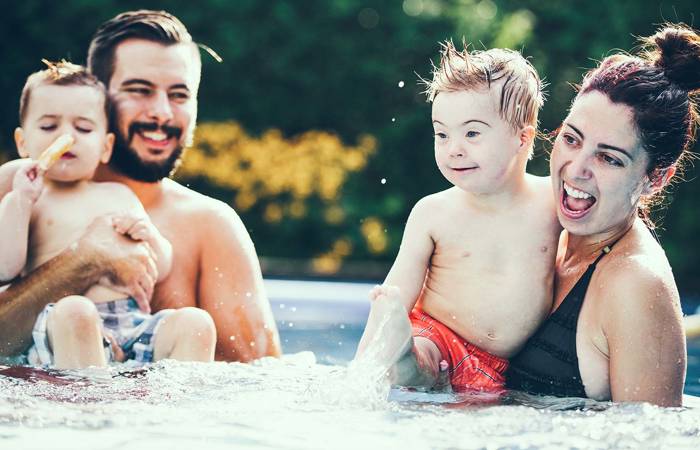Like what you see?
Sign up to receive more free parenting advice.
Thank you for subscribing to our newsletter!
Child Development

Credit: iStock.com/FG Trade
Many parents have been in that uncomfortable situation with their child as they’ve pointed at a person with a disability and in a booming voice publicly asked a personal question.
“But Mummy, why doesn’t that man have any legs?” or “Daddy that woman talks funny, what’s wrong with her?” And as you wish for the ground to swallow you whole, there are ways of dealing with the situation that will answer your child’s natural curiosity and turn a potentially uncomfortable situation into a learning opportunity.
Dr Terry Cumming, Associate Professor in Special Education in the School of Education at UNSW, says it’s important that parents teach their children that everyone is different.
“Parents should also teach their children that people have different abilities, both physical and cognitive, but we are more alike than different. They need to teach acceptance and manners. Staring at people with disabilities, avoiding them, or pretending that they are invisible is not okay! Most people would rather answer questions about their disability than be stared at rudely,” Dr Cumming says.
If your child sees a person in a wheelchair, for example, and asks “Why can’t that person walk?” there are various things a parent can say to satisfy their child’s curiosity.
It is okay to say, ‘I don’t know’
“It’s okay to answer, ‘I don’t know’ when a child asks ‘Why?’ about a disability. I would ask the person with a disability if they minded my child asking a few questions. Try to avoid pity, emotion, or going into specific detail,” Dr Cumming says.
And what should a parent say to a child who, on seeing a person with a prosthetic arm or leg asks, "Can I touch it?”.
“This would be up to the person with the prosthetic. In that case I would stress that it is never okay to just touch anyone without permission. You could ask your child, ‘Would you like it if a stranger came up and touched your arm?'.
“If you create a culture of acceptance and recognition of diversity in your family, you shouldn’t have any issues. If your child is asking a lot of questions, offer to help them find the answers later at home. Make sure that books and media that your child interacts with have positive representations of diverse people, including those with disabilities."
When it comes to appropriate terminology when talking to children about disabilities Dr Cumming suggests using positive, person-first language.
“For example, ‘person with a disability’ not ‘disabled person.’ Also avoid using degrading terms, such as ‘retarded.’ Modelling language is as important as modelling actions,” Dr Cumming says.
“Encourage children to have friends with disabilities, to be comfortable with classmates/playmates with diverse abilities. I really feel that overall it is about honesty and remembering that ‘children learn what they live'. A parent’s behaviour has the most influence on a child’s beliefs and behaviour.”
Encourage children to have friends with disabilities, to be comfortable with classmates/playmates with diverse abilities. I really feel that overall it is about honesty and remembering that ‘children learn what they live.’Dr Terry Cumming
Stay up to date with the latest news and articles from First Five Years
Thank you for subscribing to our newsletter!
It's fine for children to ask questions
Karen Dimmock, CEO of Association of Children with a Disability says it’s fine for children to ask questions about disability; it’s all about how the parent of the child asking the question responds.
“Disability is a normal part of life. When a child asks questions, giving the child an open and clear answer helps the child to understand that disability is part of human diversity. If we tell children not to ask questions, then that can give the child the impression that disability is somehow wrong or taboo,” Ms Dimmock says.
“If you know the person with disability then you can let the child know they can ask the person about their disability. However, as parents, we generally don’t encourage our children to ask strangers questions and, of course the same applies to people with disability who you don’t know.”
We all know that children are inherently curious, but what should parents say when they ask, for example, "Why can't that person walk?”.
Offer open and factual responses
Ms Dimmock says parents should always aim to give an open and clear response.
“So in response to ‘Why can’t that person walk?’, you could say ‘They might have been born like that,’ or ‘They might have had an accident'. If the person with disability is using equipment, it is good to explain what that does. So you might say, ‘They use the wheelchair to get around'.”
Ms Dimmock believes that any uncomfortable or awkward questions that a child might ask about disabilities must be answered by parents with open and clear answers.
“It is best to stick to factual language and don’t be afraid to use the word disability. Words like retard, dumb, weird and cripple are offensive. You don’t need to describe the person with disability as special. You can simply say they are blind, deaf, disabled and so on.”
“The most important thing is to ensure the child learns disability is just part of life and that you treat people with disability just like everyone else – with kindness and respect.”
And, when it comes to including children with disability into playtime with other children, the Association of Children with a Disability advises parents to include them by inviting them to parties and playdates, as you would with any other children.
“Children with disability can be left out because we don’t know what’s possible. But children with disability and their parents tend to be creative problem solvers and will let you know what can work. Children have a very different perception of disability to adults, and they can play with children with disability without seeming to notice the disability,” Ms Dimmock says.
Case study:
‘Serena’ has a 12 year old son with spina bifida who uses a wheelchair.
“When he first went to school, the teacher made sure the other kids knew about his issues and why he needed his wheelchair so there was no mystery to having him in the class. In the first few years he had plenty of questions, such as ‘How can you get in the shower or bath?’ and ‘Can you move your legs at all?’. But as he got older, the kids stopped asking him so many questions and just treated him the same as everyone else. I think the key point is to answer any questions in a very matter of fact way so there is nothing mysterious.”







